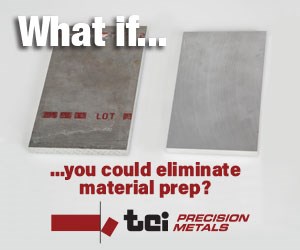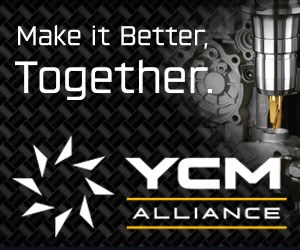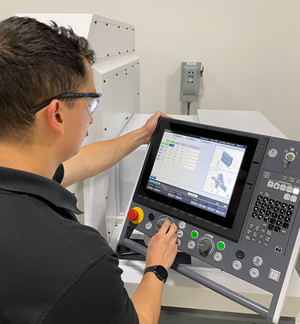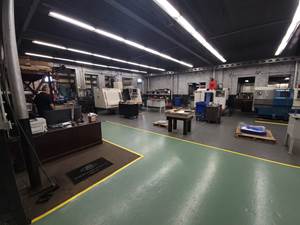Buying an HMC: Peripheral Equipment Considerations
Is it time to move up to an HMC? Let’s consider some of the peripheral equipment that HMC buyers should think about.
Share





This blog post is adapted from an article by Barry Rogers that appeared in the May edition of the Machine/Shop print supplement to Modern Machine Shop.
In the first part of this blog post series on buying a horizontal machining center (HMC), we covered some of the structural, application and design factors that differentiate HMCs from vertical machines; while in the second post, we looked at tooling- and workholding-related concerns. In this final post in the series, let’s consider some of the peripheral equipment that HMC buyers should think about.
Chip Evacuation
HMCs are designed to run long periods of time without interruption. What happens to all those chips?
With a high-pressure, through-spindle coolant system, chip evacuation on an HMC is easier than on a VMC. With a horizontal spindle, chips naturally drop into the conveyor.
Another benefit of gravity and high-pressure coolant on an HMC is that deep-pocket milling or drilling causes less wear on the tool and preserves the surface finish. Chips have a tendency to fall out of a pocket as they form rather than remain in the bottom to interfere with cutting action.
Select the best kind of chip conveyor based on the type of work you plan to do with the machine. For example, if you will be doing a lot of fine 3D surfacing, the small chips produced may slip through the cracks of a standard chip conveyor. Discuss alternate conveyor types with your dealer.
Aluminum may adhere to sidewalls of the conveyor or float into the coolant tank. Too many chips in the coolant can cause the coolant mixture to break down and lose effectiveness. Consider upgrading to drum-type filters or paper filters for the coolant system to prevent this. Integrated scrapers that remove chips from conveyor sidewalls are also helpful. Steel chips are usually easier to manage than aluminum, because steel is heavier and less likely to cling to walls or accumulate in a high-production setting. For cutting cast iron, special drum-style conveyor/separator systems will provide outstanding chip removal and keep particles as small as 50 microns out of the coolant.
Probing and Tool Setting
Spindle probing and automatic tool setting become almost mandatory when operating an HMC. The construction of an HMC makes using dial indicators and edge finders very difficult and time-consuming. Whereas the operator can open the door of a VMC to set a tool length manually, setting tools on an HMC needs to be done automatically. Whether you use an offline tool presetter or an on-machine tool setter, automating the process is the only way to go. Additional options for automation include detecting broken tools and dynamically measuring tool length and diameter to eliminate spindle or tool runout.
Spindle probing on an HMC is likewise compulsory. Machining multi-sided parts or having versatile tombstones requires using numerous fixtures and establishing multiple work offsets. Using a spindle probe makes it unnecessary to build expensive fixtures to locate the part precisely. The probe locates the part and then automatically determines and updates the work offsets without operator intervention. The spindle probe can also establish the center of the rotary table or pallet to avoid runout, detect thermal growth for compensation routines, and reduce offline inspection procedures of the machine.
Higher Programmer Skills Needed
Programming an HMC requires a higher level of skill and experience. The HMC programmer must deal with multi-sided work, handle coordinate translations in some cases and provide work offsets for each pallet, to mention a few of the extra duties. The HMC programmer must have CAM software with the features and capabilities to support this level of programming. Programming support is also required if broken-tool detection and part probing are incorporated.
Reduce Overall Cost
Compared to the VMC, an HMC offers more flexibility, increased spindle utilization, higher productivity, less work in process and faster work throughput. An HMC can provide better tool life, higher part quality and superior surface finishes. Labor costs for production with an HMC are lower as well.
All said, it is not surprising that spending on HMCs has risen substantially in recent years.
Compare machine specs from thousands of horizontal machining centers for free at techspex.com.
Find more insights about acquiring a new machining center by visiting the Techspex Knowledge Center, “Guide to Buying Machine Tools.”
Related Content
Swiss-Type Control Uses CNC Data to Improve Efficiency
Advanced controls for Swiss-type CNC lathes uses machine data to prevent tool collisions, saving setup time and scrap costs.
Read MoreFive-Axis Machines Speed NASCAR Engine Production
Moving from an aging set of five-axis mills to more advanced machines enabled Hendrick Motorsports to dramatically improve its engine production.
Read MoreFrom Tradition to Transformation: Century-Old Manual Machine Shop Adds CNCs
After 122 years of working with manual mills and lathes, this fifth-generation shop acquired assets of a local CNC machining business and hired the owner. Here’s how it’s going a year later.
Read MoreComputer Programming-Related Features of Custom Macro
Custom macro is an interpreter-based language, meaning that all CNC G code and custom macro commands are executed as the CNC comes across them.
Read MoreRead Next
Registration Now Open for the Precision Machining Technology Show (PMTS) 2025
The precision machining industry’s premier event returns to Cleveland, OH, April 1-3.
Read MoreSetting Up the Building Blocks for a Digital Factory
Woodward Inc. spent over a year developing an API to connect machines to its digital factory. Caron Engineering’s MiConnect has cut most of this process while also granting the shop greater access to machine information.
Read MoreWhy We Ask Machine Shop Leaders to Speak at TASC – The Automated Shop Conference
TASC is our industry’s premier peer-to-peer automation stage where America’s shop leaders refine the art of metalworking and CNC machining. For conference speakers, it's also an opportunity to showcase your skills and gain exposure for your business. Here are five why stepping into the spotlight at TASC could be your smartest move toward elevating your shop.
Read More





























